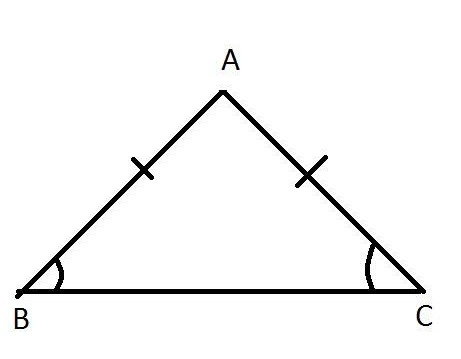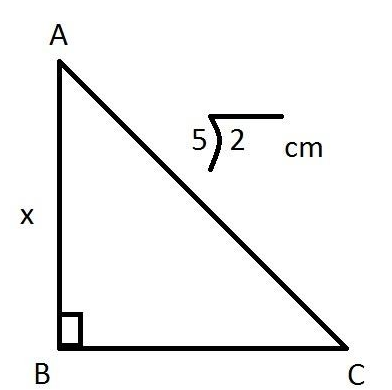
The side of an isosceles right triangle of hypotenuse \[5\sqrt 2 \] cm is:
A. \[10\] cm
B. \[8\] cm
C. \[5\] cm
D. \[3\sqrt 2 \] cm
Answer
580.8k+ views
Hint: An isosceles triangle is a triangle that has two sides of equal length sometimes it is specified as having exactly two sides of equal length and sometimes as having at least two side of equal length the isosceles triangle includes the isosceles right triangle.

ABC is an isosceles triangle whose side AB\[ = \]BC.
Isosceles right triangle:

Sides other than hypotenuse of an isosceles triangle are equal.
Complete step-by- step solution-:
Given data,
Hypotenuse of an isosceles right triangle is \[5\sqrt 2 \] cm.
\[\therefore \] Sides other than Hypotenuse of an isosceles triangle are equal.
Let the other two Sides be \[x\] each

Using Pythagoras Theorem we know that
\[A{B^2} + B{C^2} = A{C^2}\] …….. (i)
i.e. \[{(Perpendicular)^2} + {(Base)^2} = {(Hypotenuse)^2}\]
Putting values \[AB = x = BC\] and \[AB = 5\sqrt 2 \] cm in the equation(i) we get
\[{x^2} + {x^2} = {(5\sqrt 2 )^2}\] \[[\therefore \sqrt 2 \times \sqrt 2 = 2\,\,\,i.e.\,\,{(\sqrt 2 )^2} = 2]\]
\[2{x^2} = 25 \times 2\]
\[{x^2} = 25\]
\[x = \sqrt {25} \]
\[x = \sqrt {5 \times 5} \]
\[x = 5\] [Square root of \[25\] is \[5\].]
So, the required side of an isosceles triangle is \[5\]cm each. Option C
Note:
Pythagoras theorem states that “In a right-angled triangle, the square of the hypotenuse side is equal to the sum of squares of the other two sides “. The sides of this triangle have been named as Perpendicular, Base and Hypotenuse.
Pythagoras is a theorem which is used only for right angled triangles.
Which is,
\[{(Perpendicular)^2} + {(Base)^2} = {(Hypotenuse)^2}\] [Remember]
Square root of a number is a value that, when multiplied by itself, gives the number i.e. \[\sqrt {25} = \sqrt {5 \times 5} = 5\]

ABC is an isosceles triangle whose side AB\[ = \]BC.
Isosceles right triangle:

Sides other than hypotenuse of an isosceles triangle are equal.
Complete step-by- step solution-:
Given data,
Hypotenuse of an isosceles right triangle is \[5\sqrt 2 \] cm.
\[\therefore \] Sides other than Hypotenuse of an isosceles triangle are equal.
Let the other two Sides be \[x\] each

Using Pythagoras Theorem we know that
\[A{B^2} + B{C^2} = A{C^2}\] …….. (i)
i.e. \[{(Perpendicular)^2} + {(Base)^2} = {(Hypotenuse)^2}\]
Putting values \[AB = x = BC\] and \[AB = 5\sqrt 2 \] cm in the equation(i) we get
\[{x^2} + {x^2} = {(5\sqrt 2 )^2}\] \[[\therefore \sqrt 2 \times \sqrt 2 = 2\,\,\,i.e.\,\,{(\sqrt 2 )^2} = 2]\]
\[2{x^2} = 25 \times 2\]
\[{x^2} = 25\]
\[x = \sqrt {25} \]
\[x = \sqrt {5 \times 5} \]
\[x = 5\] [Square root of \[25\] is \[5\].]
So, the required side of an isosceles triangle is \[5\]cm each. Option C
Note:
Pythagoras theorem states that “In a right-angled triangle, the square of the hypotenuse side is equal to the sum of squares of the other two sides “. The sides of this triangle have been named as Perpendicular, Base and Hypotenuse.
Pythagoras is a theorem which is used only for right angled triangles.
Which is,
\[{(Perpendicular)^2} + {(Base)^2} = {(Hypotenuse)^2}\] [Remember]
Square root of a number is a value that, when multiplied by itself, gives the number i.e. \[\sqrt {25} = \sqrt {5 \times 5} = 5\]
Recently Updated Pages
You are awaiting your class 10th results Meanwhile class 7 english CBSE

Master Class 7 Social Science: Engaging Questions & Answers for Success

Master Class 7 Science: Engaging Questions & Answers for Success

Class 7 Question and Answer - Your Ultimate Solutions Guide

Master Class 7 English: Engaging Questions & Answers for Success

Master Class 7 Maths: Engaging Questions & Answers for Success

Trending doubts
Convert 200 Million dollars in rupees class 7 maths CBSE

Full Form of IASDMIPSIFSIRSPOLICE class 7 social science CBSE

i What trees does Mr Wonka mention Which tree does class 7 english CBSE

What are the controls affecting the climate of Ind class 7 social science CBSE

What was the main occupation of early Aryans of rig class 7 social science CBSE

Write a letter to the editor of the national daily class 7 english CBSE





